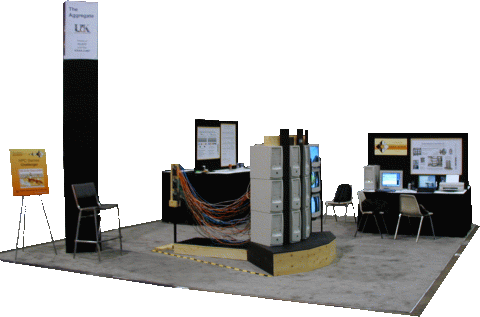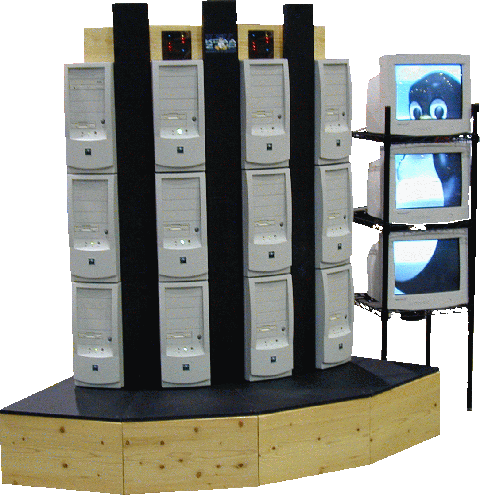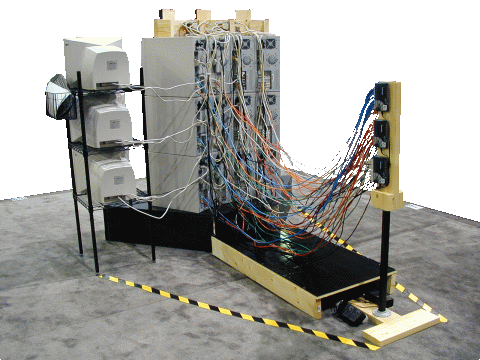 The Aggregate research exhibit at SC2000
The Aggregate research exhibit at SC2000
(this is where the KRAA Z-MP was for the HPC Games)
November 2000, Dallas, Texas: At the IEEE/ACM SC2000 conference on high-performance networking and computing, The Aggregate research group at the University of Kentucky was the only group to win two unrelated awards. For its application work, the group was given a Gordon Bell award (Honorable Mention in Price/Performance); for the architecture of the KRAA Z-MP cluster supercomputer, the group received an HPC Games award (Most Innovative Hardware).
Since 1987, the Gordon Bell Prizes have been awarded to recognize outstanding achievements in high-performance computing. Awards in the price/performance category are given to entries demonstrating an outstanding price-performance ratio as measured in dollars cost per million floating-point arithmetic operations per second (MFLOPS) achieved while executing a genuine application. The Kentucky team, Thomas Hauser, Tim Mattox, Ray LeBeau, Hank Dietz, and George Huang, was given an Honorable Mention in Price/Performance for its work "High-Cost CFD on a Low-Cost Cluster." CFD - Computational Fluid Dynamics - problems require notoriously complex computations; the group achieved a record price/performance of $1.86/MFLOPS simulating the airflow around a turbine blade.
In large part, the outstanding price/performance on the CFD application was due to two major advances in the design of the supercomputer that ran the code: KLAT2, Kentucky Linux Athlon Testbed 2. KLAT2 is a cluster supercomputer that unites sixty-four 700MHz AMD Athlon PCs. Each of the processors achieves unusually high performance by using the 3DNow! instructions, which were intended to speed-up multimedia games, to provide a similar performance boost for the CFD arithmetic. The second advance involves the way that the PCs interact; a deliberately asymmetric Flat Neighborhood Network (FNN) built using multiple standard 100Mb/s Ethernets yields performance comparable to gigabit networks at a small fraction of the cost. Earlier this year, these technologies were responsible for KLAT2 becoming the first supercomputer to run a standard application benchmark (ScaLAPACK) with price/performance better than $1/MFLOPS.
At SC2000, the Kentucky team also competed in the first HPC (High-Performance Computing) Games Challenge. The goal of the HPC Games was to see who could achieve the best performance on a very large set of benchmark programs using a machine that costs less than $10,000. The Aggregate's entry was another Linux cluster ("Beowulf") supercomputer, the KRAA Z-MP, Kentucky Research AMD Athlons Z. - Multiple PCs. Although using only eleven 700MHz and one 1.2GHz Athlon, the KRAA Z-MP employs both the 3DNow! and FNN technologies used in KLAT2 and also integrates an Aggregate Function Network (AFN) and 3-monitor video wall. The special abilities of this system were recognized by the "Most Innovative Hardware" award. The team that "battled the benchmarks" using the KRAA Z-MP live at SC2000 was Tim Mattox, Bill Dieter, Hank Dietz, Thomas Hauser, Todd Willey, Harry Peiris, and Jim Lumpp.
At SC99, The Aggregate research exhibit demonstrated one of the first Linux clusters built using AMD Athlons. It is interesting to note that the SC2000 HPC Games were dominated by AMD Athlons: of over 650 benchmarks on which scores were reported, 96% were won by AMD Athlons. In benchmarks that took advantage of the KRAA Z-MP's special properties, such as measuring network bisection bandwidth (using the FNN) or some of the cache/memory bandwidth benchmarks (using our compiler support for MMX/3DNow!), it was the clear winner. However, the special features of the KRAA Z-MP made it impossible to run quite a few of the benchmarks (e.g., PVM internally uses a routing scheme which is somewhat incompatible with the FNN); for those benchmarks, "The Red Team" from Rome Laboratories won with their cluster of Athlons connected by a single 100Mb/s Ethernet.
Click on any of the following photos to get the full-size image.
 The Aggregate research exhibit at SC2000
The Aggregate research exhibit at SC2000
(this is where the KRAA Z-MP was for the HPC Games)
 The KRAA Z-MP cluster supercomputer
The KRAA Z-MP cluster supercomputer
(the Cray-shaped Athlon PC cluster used live at SC2000 in the HPC Games)
 The back of the KRAA Z-MP at SC2000
The back of the KRAA Z-MP at SC2000
(the AFN is on top of the PCs, the FNN wiring extends back to six 8-port switches)
 A visualization of the CFD simulation output
A visualization of the CFD simulation output
(output from the CFD code that won the Gordon Bell award)
 The KLAT2 cluster supercomputer
The KLAT2 cluster supercomputer
(the Athlon PC cluster in Lexington, Kentucky, that ran the CFD code)
This press release online, http://aggregate.org/press001122.html, provides a number of links to supporting materials.
If you have any questions or comments, contact:
Professor Hank Dietz, James F. Hardymon Chair in Networking
University of Kentucky
College of Engineering
Electrical Engineering Department
453 Anderson Hall
(Office 307 EE Annex, Lab 672 Anderson Hall)
Lexington, KY 40506-0046
Office Phone: (859) 257 4701
Lab Phone: (859) 257 9695
Fax : (859) 257 3092
Email: [email protected]
Home URL: http://aggregate.org/hankd/